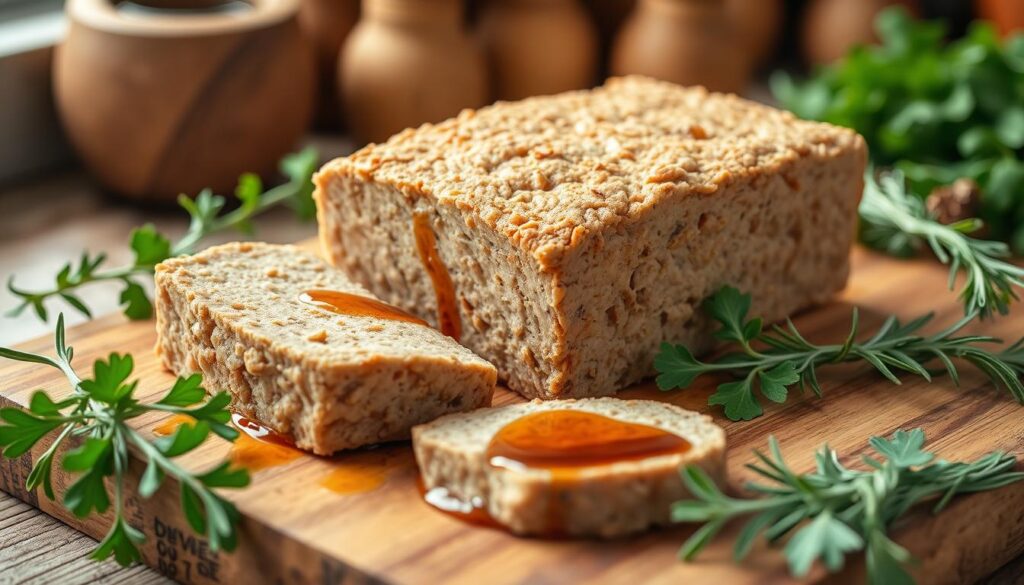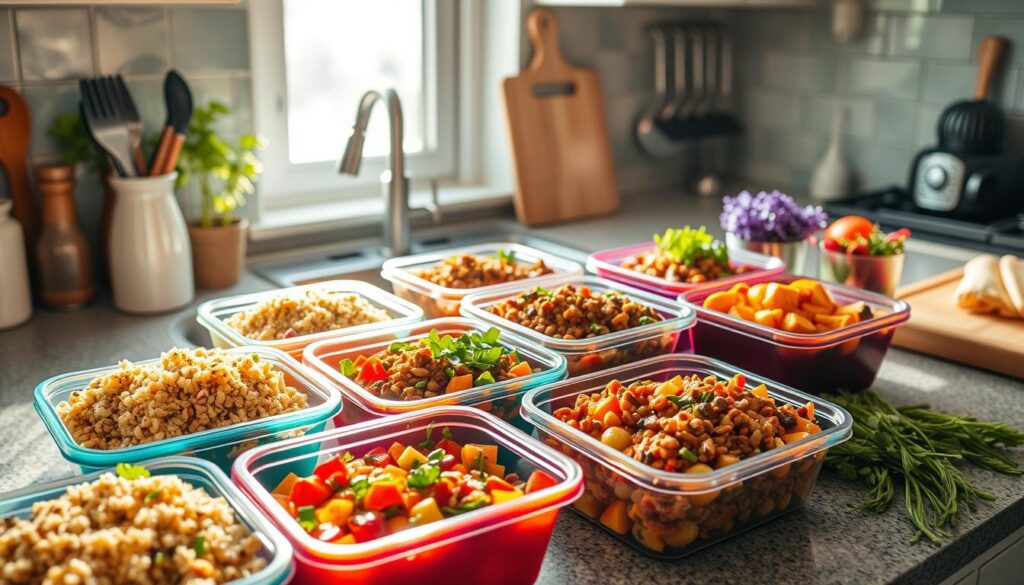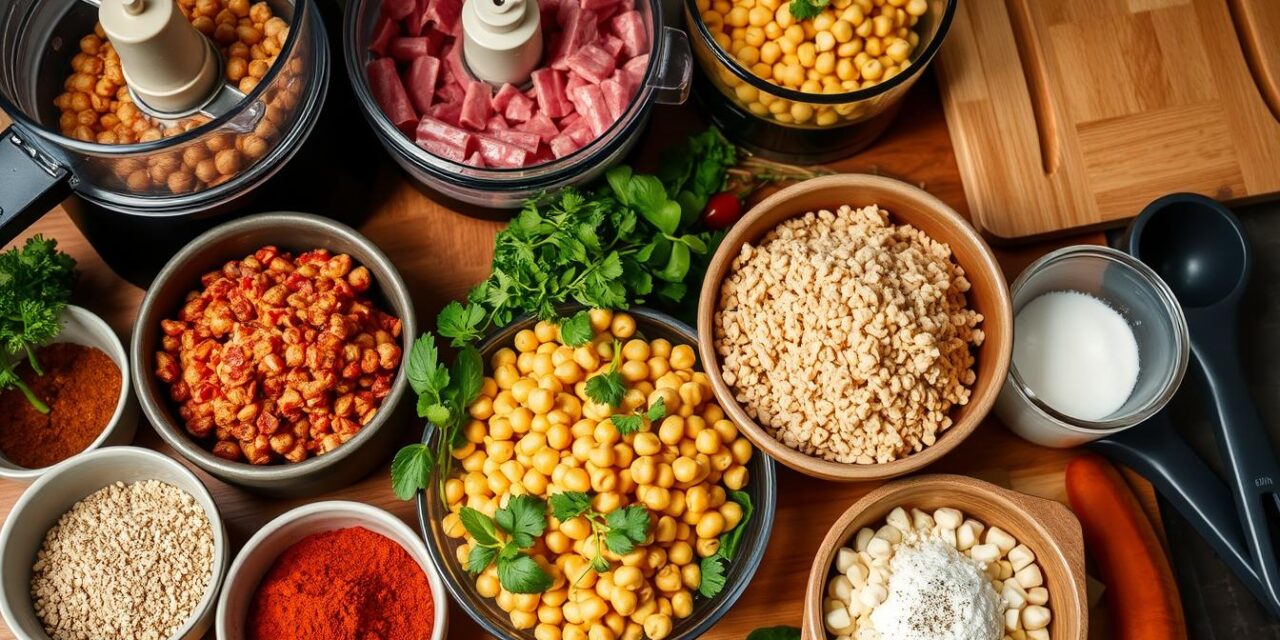Did you know the global vegan meat market is set to hit $8.3 billion by 2025? This huge growth shows how popular meat alternatives are getting. More Australians are trying vegan meat recipes and finding they’re tasty and healthy.
This guide will show you how to make tasty vegan meat dishes. They’re not just good for you but also for the planet. You’ll learn about plant-based proteins, making seitan, and creating the best vegan burgers. Get ready to become a pro at making delicious meat alternatives at home.
Key Takeaways
- The global vegan meat market is projected to reach $8.3 billion by 2025, showcasing the growing popularity of plant-based proteins.
- Vegan meat recipes offer a delicious and nutritious alternative to traditional animal-based meats.
- Discover the health benefits and environmental impact of embracing a plant-based diet.
- Learn essential techniques for creating seitan, vegan burgers, and other meat alternatives at home.
- Explore a variety of vegan bacon, sausage, tofu, and tempeh recipes to satisfy your cravings.
Understanding Plant-Based Proteins and Their Benefits
More people are choosing plant-based diets, leading to a big demand for plant-based proteins. These proteins are good for the planet and our health. They offer many nutritional benefits and are better for the environment.
Essential Amino Acids in Vegan Proteins
Many think plant-based proteins lack essential amino acids. But, a mix of different plant foods can give you all you need. A vegan cookbook can help you get the right mix of meat alternatives like legumes, grains, and nuts.
Health Benefits of Switching to Meat Alternatives
Choosing plant-based proteins can make you healthier. It can lower your risk of heart disease, diabetes, and some cancers. Vegan proteins are also better for your heart because they have less bad fat and cholesterol.
Environmental Impact of Plant-Based Diets
Plant-based diets are great for the planet. They need less land, water, and energy than animal products. Switching to plant-based proteins can make a big difference in reducing pollution and helping the environment.
| Nutrient | Animal-Based Proteins | Plant-Based Proteins |
|---|---|---|
| Protein Quality | Complete, high-quality | Typically incomplete, but can be combined for a complete profile |
| Saturated Fat | Generally higher | Generally lower |
| Cholesterol | Present | Cholesterol-free |
| Environmental Impact | Higher resource use (land, water, energy) | Lower resource use (land, water, energy) |
Essential Ingredients for Creating Vegan Meat Recipe
Making tasty vegan meat alternatives needs the right ingredients. At the core are the vegetable proteins, giving texture and nutrition. Let’s look at the key parts that make plant-based foods into tasty vegan meat recipe dishes.
Vital Wheat Gluten: The Protein Powerhouse
Vital wheat gluten is a big deal in vegetable proteins. It’s a concentrated wheat protein that makes food chewy and fibrous, like meat. It’s great for making vegan burgers and sausages.
Legumes: The Versatile Plant-Based Allies
Legumes like chickpeas, lentils, and black beans are crucial in meat substitutes. They add protein, a rich flavour, and a filling texture to vegan dishes.
Nutritional Yeast: The Umami Enhancer
Nutritional yeast gives vegan dishes a cheesy, savoury taste. It boosts the umami in vegan meat recipe mixes, making them taste more like meat.
| Ingredient | Purpose | Where to Find |
|---|---|---|
| Vital Wheat Gluten | Provides chewy, fibrous texture | Health food stores, specialty grocers |
| Legumes (Chickpeas, Lentils, Black Beans) | Contributes plant-based protein and texture | Supermarkets, health food stores |
| Nutritional Yeast | Enhances umami flavour | Health food stores, specialty grocers |
By mixing these key ingredients, anyone can make tasty vegan meat recipe dishes. They turn simple plant-based foods into satisfying meat-like options.
Kitchen Tools and Equipment You’ll Need
Starting your vegan cooking journey? The right kitchen tools and equipment are key. They help make cooking delicious meatless dishes easier. We’ll look at the essential appliances, mixing and measuring tools, and storage solutions for vegan meat replacement.
Must-Have Appliances for Meat Alternatives
For better vegan meat-making, get these appliances:
- Food Processor: It blends, chops, and purees ingredients for perfect vegan meat texture.
- High-Speed Blender: Needed for smooth, creamy vegan meat bases like nut-based mince or patties.
- Dehydrator: Essential for making vegan jerky or dried meat alternatives.
Recommended Mixing and Measuring Tools
Accurate mixing and measuring are crucial for great vegan meat recipes. Here are some tools to consider:
- Mixing Bowls: Sturdy, various-sized bowls help mix ingredients well.
- Measuring Cups and Spoons: Essential for precise measurements in vegan meat recipes.
- Spatulas and Wooden Spoons: Great for mixing and achieving the right texture.
Storage Solutions for Homemade Vegan Meats
Keeping your homemade vegan meats fresh is important. Here are some storage solutions:
| Storage Method | Benefits |
|---|---|
| Airtight Containers | Keep vegan meats fresh and prevent oxidation, extending shelf life. |
| Freezer-safe Bags or Containers | Store larger batches for longer, perfect for meal prep. |
| Silicone Molds | Make portioning and shaping vegan meat patties or sausages easy. |
With the right kitchen tools and equipment, you can make amazing vegan meat recipes at home. Let your creativity flourish in your meatless dishes.
Mastering Seitan: The Wheat Meat Alternative
Seitan, a wheat-based meat substitute, is loved by many vegans and vegetarians in Australia. It can be turned into many different dishes, making it a great choice for those who don’t eat meat. Learning to make seitan is rewarding, opening up a world of tasty and healthy vegan dishes.
Seitan is made from wheat gluten. By kneading and cooking it, you get a texture that feels like meat. You can season and shape it in many ways. It’s perfect for making dishes that taste like chicken, beef, or pork.
Seitan-Making Essentials
- High-quality wheat gluten flour: The key to achieving the desired seitan texture.
- Savory seasonings: Experiment with spices, herbs, and umami-rich ingredients to create your signature flavour profile.
- Kneading technique: Proper kneading helps develop the gluten structure, resulting in a firm and chewy texture.
- Cooking method: Simmering, steaming, or baking seitan allows you to control the final consistency.
With a few simple steps and practice, you’ll get the hang of making seitan at home. Enjoy exploring the endless possibilities and let your creativity shine. Discover the amazing world of vegan meat recipes.

Remember, finding and perfecting seitan recipes is a tasty journey. Have fun trying new flavours and techniques. Let your taste buds guide you as you master seitan.
Creating Perfect Vegan Burger Patties
Making tasty vegan burger patties is an art. With the right techniques, you can make your plant-based food amazing. This guide will help you make the perfect vegan burger, whether you’re new or experienced.
Binding Ingredients for Better Texture
The secret to a great vegan burger patty is in the binding ingredients. Use tofu, tempeh, or seitan for a firm texture. Breadcrumbs, oats, or ground nuts add crunch and help the patty stay together.
Seasoning Secrets for Authentic Flavour
Seasoning is key to delicious vegan burgers. Mix savoury spices like garlic powder, onion powder, and smoked paprika. Add soy sauce or vegan Worcestershire sauce for extra flavour.
Cooking Methods and Times
- Grilling: Preheat your grill to medium-high heat and cook the patties for 4-5 minutes per side, or until they develop a delectable char.
- Pan-frying: Heat a lightly oiled non-stick pan over medium heat and cook the patties for 3-4 minutes per side, or until they’re golden brown and crispy.
- Baking: Preheat your oven to 375°F (190°C) and bake the patties for 15-20 minutes, flipping halfway, until they’re firm and lightly browned.
Choose your cooking method wisely. Handle the patties gently to keep their shape and texture. The perfect vegan burger patties come from the right mix of ingredients and cooking.
Plant-Based Bacon and Sausage Alternatives
Looking to eat less meat or go vegan? Plant-based bacon and sausages are tasty and fulfilling. They taste and feel like real meat but are better for you and the planet.
Tempeh, a soybean cake, is great for vegan bacon. It gets firm and tastes like bacon when marinated and smoked. Coconut is also fantastic, crisping up and tasting smoky and salty.
Vegan sausages use different proteins like seitan, mushrooms, and beans. Seasoned with herbs and spices, they taste just like real sausages but are animal-free.
| Vegan Bacon Ingredients | Vegan Sausage Ingredients |
|---|---|
|
|
Try these vegan bacon and vegan sausages for a meaty taste without the guilt. They’re good for the planet and support a greener meat replacement diet.
Tofu and Tempeh Transformation Techniques
Tofu and tempeh are great for making tasty meat alternatives. With a few techniques, you can make them into delicious vegan dishes. They can please even the pickiest eaters.
Marination Methods for Maximum Flavour
The key to flavourful tofu and tempeh is a good marinade. You can use soy-based or herb-infused marinades. Let them soak for at least 30 minutes or overnight for the best taste.
Pressing and Preparing Techniques
Getting the right texture is important. Pressing out excess moisture helps with flavour and crispiness. You can also slice, cube, or crumble them for different tofu dishes and meat alternatives.
Cooking Methods for Different Textures
Changing the cooking method can change the texture of tofu and tempeh. Try baking, sautéing, or braising for different textures. This way, you can make a variety of vegan lunch options.
| Cooking Technique | Tofu Texture | Tempeh Texture |
|---|---|---|
| Baking | Crispy, firm | Chewy, dense |
| Sautéing | Lightly crisp on the outside, soft inside | Caramelized, slightly crunchy |
| Braising | Soft, silky | Tender, absorbent |
“Discovering the versatility of tofu and tempeh has revolutionised my approach to plant-based cooking. The possibilities are endless when you unlock their transformative potential.”
Storage Tips and Meal Prep Strategies
Making tasty vegan meat dishes at home is rewarding. But keeping them fresh is just as important. We’ll look at storage tips and meal prep strategies to help you enjoy your homemade dishes longer.
Refrigeration and Freezing 101
Storing your vegan meats right is crucial. Here are some tips to keep them fresh:
- Refrigerate cooked vegan meats in airtight containers for up to 5 days.
- Freeze uncooked vegan meats for longer-term storage, up to 3 months.
- Thaw frozen vegan meats in the fridge overnight before use for optimal texture.
Portioning and Meal Prepping
Make planning your vegan meals easy with these tips:
- Portion cooked vegan meats into individual servings before refrigerating or freezing.
- Incorporate vegan meats into your weekly meal plans, ensuring they’re ready to use when needed.
- Experiment with different vegan meat recipes to build a repertoire in your vegan cookbook.
Learning to store and prepare your vegan meats well means you can enjoy them anytime, anywhere.

“Meal prepping with vegan meats is a game-changer – it saves time, reduces waste, and ensures I have delicious plant-based options on hand whenever I need them.”
Troubleshooting Common Vegan Meat Making Issues
Making vegan meat at home can be fun and rewarding. But, it comes with its own set of challenges. You might struggle to get the perfect texture or find that elusive umami flavour. But, there are solutions to these common problems.
Texture Problems and Solutions
Getting the right texture in vegan meat can be tough. If your seitan or patties are too dry, add more aquafaba, vegetable broth, or plant-based milk. This will help keep them moist.
If your vegan meat is too wet, add more vital wheat gluten or breadcrumbs. This will help it hold together better.
Flavour Adjustment Guidelines
Getting the flavour right in vegan meat can be tricky. But, with a few tips, you’ll soon be making delicious meat alternatives. If your vegan bacon or sausage lacks savoury taste, add more nutritional yeast, soy sauce, or smoked paprika. This will enhance the umami.
For a bolder flavour, try using aromatic herbs, spices, and marinades. The secret to great vegan meat is finding the right balance of seasonings for your taste.





